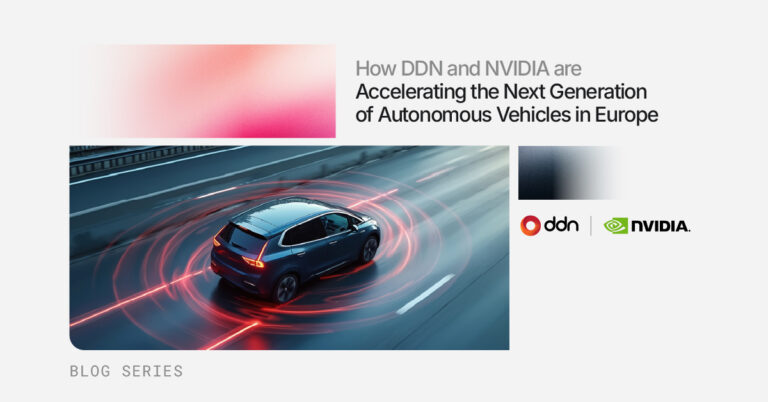Autonomous vehicles (AVs) are shifting from concept to reality, and Europe is emerging as a key innovation hub. NVIDIA’s recent announcement to bring its full-stack autonomous driving software platform into Europe marks a major milestone in this transformation.
But autonomy isn’t just an AI challenge—it’s a data challenge. Real-time driving decisions depend on the ability to move, process, and manage massive sensor data volumes with near zero latency. That’s where DDN and NVIDIA are building the intelligent data infrastructure that fuels autonomy at scale.
Autonomous Vehicles as AI Factories on Wheels
Every autonomous vehicle operates as a data center on wheels, generating 1-5 terabytes of data per hour from sensors like LiDAR, radar, cameras, and telemetry.
The speed at which this information must move through the system is staggering. Each data stream must be ingested, tagged, and made available to AI models in real time. A delay of even a few milliseconds can mean the difference between a safe stop and a system error.
As these data streams move from edge (vehicle) to core (regional data center) to cloud (simulation and retraining), they demand a new type of infrastructure — one designed for AI-driven data intelligence rather than legacy file storage.
This is why automotive innovators are embracing the Data Intelligence Platform model, built to connect edge-to-core-to-cloud workflows seamlessly and power AI factories that continuously retrain and refine autonomous models.
Why Traditional Storage Can’t Keep Up with Autonomous AI
Conventional enterprise and cloud-native storage systems were not designed for AI workloads. They suffer from:
- Latency measured in tens of milliseconds (not sub-milliseconds)
- Limited metadata tagging and indexing
- Inefficient edge-to-core synchronization
- Fragmented governance and audit capabilities
DDN’s Infinia Data Intelligence Platform solves these limitations by unifying ingest, metadata, orchestration, and governance in a single intelligent platform.
- For automotive developers, this means:
- Faster AI model retraining
- Simplified infrastructure management
- Reduced total cost of ownership
- End-to-end performance visibility and compliance readiness
NVIDIA’s Full-Stack AV Rollout Across Europe
NVIDIA’s entry into the European AV ecosystem brings together all the critical building blocks for autonomous driving, including:
- DRIVE AV: Real-time perception, localization, and planning
- DRIVE OS: Compute orchestration across the vehicle
- DRIVE Maps: High-definition maps and digital twins for simulation
All of these components are linked to AI factories, where massive volumes of data are processed to refine and retrain models continuously.
What makes this announcement especially significant for European automakers is its breadth. This is not simply software embedded in the car; it is an end-to-end ecosystem. It introduces the requirement for large-scale, real-time data management across multiple countries, each with its own regulations, infrastructure standards, and compliance frameworks.
To succeed, automakers and suppliers need more than just the NVIDIA stack. To succeed they need a data platform that can keep pace with it.
Infinia: The Data Intelligence for Autonomous Driving
This is precisely the role of DDN Infinia. Unlike conventional storage systems, Infinia was purpose-built to manage the unique demands of AI-powered, data-intensive workloads like those in autonomous driving. It is software-defined, cloud-native, and edge-ready, allowing data to move fluidly between vehicles, local data centers, and global cloud regions.
Key performance advantages include:
- Sub-millisecond latency and 95%+ throughput efficiency
- 600× faster metadata search than AWS S3
- Native integration with NVIDIA NeMo, NIM, and Spark
- Immutable object locking for compliance and data protection
These capabilities allow automotive teams to move data effortlessly from capture to training to inference—without breaking AI workflows.
From Edge to AI Factory: Real Results in Motion
To understand the impact of Infinia, consider a Tier 1 automotive supplier operating AV test fleets across Germany and France. Facing bottlenecks in simulation replays and compliance workflows, they turned to Infinia. With real-time ingest and metadata tagging, their AI model retraining cycles dropped from 72 hours to under 24.
At the edge, sensor data is ingested in real time and immediately enriched with metadata such as GPS coordinates, time stamps, and sensor type. When this data reaches the data center, Infinia’s event-driven architecture automatically triggers workflows: new data may initiate a retraining process, flag an anomaly for compliance review, or launch a simulation replay. Because Infinia integrates natively with NVIDIA NeMo and NIM, the transition into model training and inference happens without additional overhead.
The governance layer is just as critical. With immutable object locking, audit-ready trails, and legal hold features, Infinia ensures that all data is protected and compliant with standards like ISO 26262 and GDPR. This is essential in Europe, where data privacy and safety compliance are not optional, they are regulatory imperatives.
The benefits of this approach are clear. GPU utilization rises by as much as 30 percent, meaning more value is extracted from existing compute investments. Time-to-insight decreases dramatically, allowing automakers to iterate models faster and deploy safer vehicles sooner. What once took weeks to process can now be done in days, or even hours.
A Proven Partnership with NVIDIA
The integration between NVIDIA and DDN is not theoretical. By integrating directly with NeMo, NIM, and NVIDIA’s Base Command platform, Infinia ensures that AV teams can move from data ingest to inference without interruption. This is the foundation of the AI Factory model, where massive data volumes are continuously transformed into smarter, safer driving models.
Data Intelligence as a Competitive Edge
The race to autonomous driving leadership will not be won by algorithms alone. It will be determined by how quickly and intelligently those algorithms can be trained, updated, and deployed. That requires infrastructure capable of handling real-time ingest, continuous retraining, global compliance, and seamless collaboration between simulation and production teams.
DDN Infinia is more than compatible with NVIDIA’s vision and is the platform that enables it. By delivering ultra-low latency, intelligent metadata management, and governance at scale, Infinia empowers automotive companies to turn data into a true competitive advantage.
Conclusion: From AI to Autonomy – The Infrastructure That Drives It All
In Europe’s race toward AV leadership, the differentiator won’t be whose software runs fastest; it will be who trains better, deploys faster, and adapts in real time. That requires infrastructure purpose-built for AI at every step. With NVIDIA defining the AV software stack and DDN Infinia enabling it, the industry now has both the intelligence and the engine to move autonomy from pilots to production.
For organizations serious about scaling autonomous systems, the message is clear: data intelligence isn’t just part of the AV stack, it is the AV stack. To learn more, contact an AI specialist.
It’s an integrated system that unifies data ingest, metadata, and AI workflow orchestration—enabling faster model training, validation, and deployment.
Milliseconds can determine driving safety. Low-latency infrastructure ensures real-time decision-making from vehicle to data center to cloud.
Infinia delivers 95%+ throughput efficiency, 600× faster metadata search, and seamless NVIDIA integration—reducing complexity and costs.
An AI Factory continuously ingests, processes, and retrains AI models using real-world data to improve performance and safety in production environments.
With immutable object locking, traceability, and governance aligned with ISO 26262 and GDPR standards.


